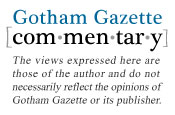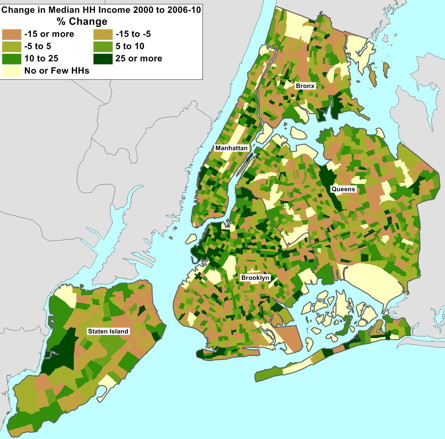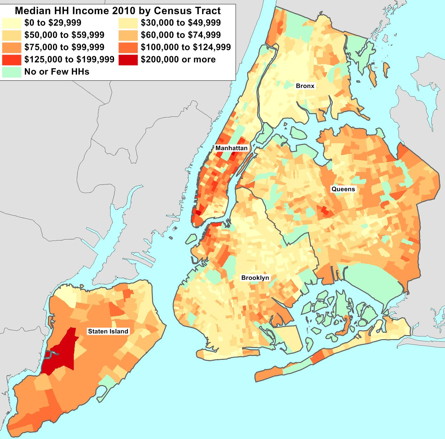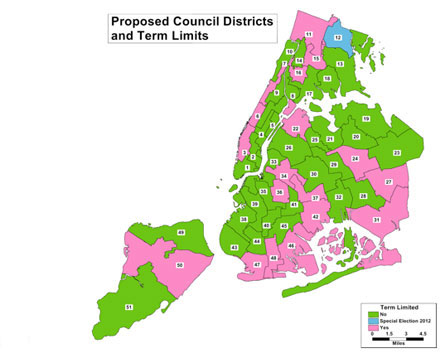New Plan For City Council Districts

NEW YORK — A new proposed map for New York City Council district lines addresses some concerns of civil rights groups and reflects changing demographics, while also safeguarding incumbents.
But the Districting Commission was criticized for voting to approve the new plan at a meeting Thursday night before it had even released the information to the public. The full City Council must now approve the new map.
Since the commission also supplied an analysis related to the Voting Rights Act by Lisa Hadley, a renowned expert in that field, it is clear that the revised plan had been crafted days ago and could have been released at the Commission’s discretion.

The above map presents a view of the revised plan for new Council districts, along with whether or not the current incumbent is term limited. Courtesy of Social Explorer.
It took until Friday afternoon for the revised district plan to be posted on the Commission’s website for the public to view it.
Asked why the map was not released to the public before the Commission voted to approve it, the Commission’s executive director, Carl Hum, said there was still time for the public to make its comments on the plan.
“If there is a desire by the public to have more hearings, they can certainly voice that to the Council,” he said. The Council could also reject the lines, forcing the Commission to hold another hearing. “The process is far from over.”
He said that the new map was drawn taking into account comments from the public, civil rights groups and legislators, as well as maps created by members of the public.
Responding to criticism that the lines had been drawn to protect incumbency, he said legislators’ also had a stake in the process. “While not saying that's the primary consideration, or the overarching consideration … It is part of the toolkit,” he said.
>>>>Read Andrew A. Beveridge's analysis of the preliminary maps and how they protect incumbents.
Unlike the state, the city has a non-legislative redistricting commission, which has held hearings and a series of maps.
The commission consists of 15 members — seven appointed by the mayor, five by the Council Democrats and three by the Council Republicans. One third of the commissioners are from Manhattan, which has about one-fifth of the population, two from the Bronx and Brooklyn each, and three from Staten Island and Queens each.
This structure is seen by some political observers as an advance over the redistricting process at the state level, where legislators themselves were able to draw the lines for the Assembly and Senate lines after Gov. Andrew Cuomo waffled on his promise to veto any maps that were clearly gerrymandered.
Nevertheless, the proposed maps have been criticized for dividing neighborhoods and ignoring communities of shared interest.
>>>View a table about the new districts under the revised plan, including the incumbent, the year elected, term limit status, voting age, citizenship, race and Hispanic status.
The Unity coalition of minority advocates — including LatinoJustice PRLDEF, Asian American Legal Defense And Education Fund, and Center for Law and Social Justice at Medgar Evers College — presented a common plan that attempted to keep neighborhoods intact and attempted to maximize the influence of African Americans, Latinos and Asian Americans on the new Council.
In a statement released after Thursday night’s vote by the Commission, AALDEF noted that under the new proposed map that several Asian American communities remained divided but that some of the Unity Map’s suggestions were taken into account.
Jerry Vattamala, a staff attorney with ALDEF, said in a statement that the Commission’s proposed map “has room for improvement in enabling New York City’s federally protected communities of color to have an equal opportunity to elect candidates of their choice.”
___
Image of New York City, seen from space, courtesy of NASA.
Proposed City Council District Map Protects Incumbents

Editor's note: This commentary is based on the preliminary lines that were released before Thursday night's meeting by the Districting Commission. We will be updating it with additional information as it is released.
NEW YORK — The once-a-decade drama of redistricting the New York City Council is almost complete.
Much is at stake, not for party control, but over who will represent many of the city’s increasingly diverse neighborhoods for the next decade beginning with the 2013 election. Redistricting must be undertaken after each federal decennial Census.
The city's Districting Commission, appointed by the mayor and Council leaders to redraw the lines, voted unanimously in favor of a revised plan at a public meeting Thursday night. The new map has not been made available for review. The full City Council must now approve it.
The current Council has 46 Democrats and five Republicans. In 2013, an additional 18 seats will be open due to the impact of the change in the city’s charter regarding term limits. How those districts are drawn will have a lot to do with recruiting new political leadership in New York City for the next decade.
Unlike the state, the city has a non-legislative redistricting commission, which has held hearings and presented preliminary maps of the boroughs.
The commission consists of 15 members — seven appointed by the mayor, five by the Council Democrats and three by the Council Republicans. One third of the commissioners are from Manhattan, which has about one-fifth of the population, two from the Bronx and Brooklyn each, and three from Staten Island and Queens each. The most populous boroughs (Brooklyn and Queens) have almost three-fifths of the population, but the same number of commissioners as Manhattan. Staten Island, with not even six percent of the city’s population, has one-fifth of the commissioners. The commission has an executive director and a staff.
This structure is seen by some political observers as an advance over the redistricting process at the state level, where legislators themselves were able to draw the lines for the Assembly and Senate lines after Gov. Andrew Cuomo waffled on his promise to veto any maps that were clearly gerrymandered.
But since they are appointed by the mayor and the Council, it is perhaps unsurprising that the commissioners charged with redrawing the city's districts would follow the age old practice of “incumbency protection”: In the draft map that was released before Thursday's vote on a revised plan, district lines were tweaked at the expense of splitting some neighborhoods. This is a classic example of protecting those already in office by minimizing the amount of change within district lines — after all, probably the worst thing that can happen to an incumbent is to force him or her to run in a new district.

This seemingly business-as-usual approach appears to be in stark contrast to the Districting Commission’s efforts to be transparent about the process, allow for community input at hearings in the various boroughs and through an invitation to members of the public to submit their own proposed maps. Nevertheless, the proposed maps have been criticized for dividing neighborhoods and ignoring communities of shared interest.
The Unity coalition of minority advocates — including LatinoJustice PRLDEF, Asian American Legal Defense And Education Fund, and Center for Law and Social Justice at Medgar Evers College — presented a common plan that attempted to keep neighborhoods intact and attempted to maximize the influence of African Americans, Latinos and Asian Americans on the new Council. Most of their suggestions were spurned, likely because many of them would have made it much more difficult for incumbents to keep their seats, or would have forced incumbents to accommodate themselves to new neighborhoods.
Despite the outcry from the Unity coalition and other groups, the Commission has proposed a plan that is basically same-old, same-old.
The above map presents a preliminary view of the new Council districts, along with whether or not the current incumbent is term limited. Click to enlarge. Courtesy of Social Explorer.
Redistricting Standards
To successfully complete redistricting and not be subject to challenge under federal law, the following principles must be followed:
- Relative population equality — generally, this is interpreted as being within plus or minus five percent of the average or ideal district size based here upon the population adjusted for prisoner locations.
- Contiguity — that the districts are in one piece.
- Compactness — that the districts are compact in shape.
- Political boundaries — that the districts do not split political or community boundaries.
- Given all of the above, that they keep racial and Hispanic communities together.
The fifth provision is very important in New York City, since the Bronx, Manhattan and Brooklyn are subject to pre-clearance by the U.S. Department of Justice. One of the main issues with pre-clearance relates to retrogression, meaning that the number of seats with a majority of the various minority groups from the 2003 districts must result in the same number or more seats unless population change makes this impossible.
It is this last point that has created the presents the biggest challenge to the Commission’s map-making.
Current Districts and Need for Change
Since redistricting is like putting together a jigsaw puzzle, that 12 seats need to be adjusted, means that many more than that will be impacted, because the extra population to be added or subtracted from these 12 districts will need to come from or be put elsewhere. So substantial redistricting was necessary.
The Council currently has 2 Asians, 15 blacks, 8 Latinos, and one Black/Latino Councilman. But non-Hispanic whites make up 25 of the 51 seats in the Council. In terms of minority majority seats, the new Council will have nine majority Latino seats, 11 majority African American seats and one seat that is almost majority Asian. There are 21 non-Hispanic white seats and nine with no majority. Of those nine, five are plurality non-Hispanic white and four are plurality Hispanic. Based upon proportional representation by seats, the current Council is over-performing in returning minority districts.
>>>View a table about the new districts under the preliminary plan, including the incumbent, the year elected, term limit status, voting age, citizenship, race and Hispanic status.
The Unity coalition proposed a plan that would result in one more majority black district and one less majority Hispanic district. The Unity coalition asserts that their plan divides fewer neighborhoods. Such changes would be even more disruptive to the current set of incumbents, so was not seriously considered.
Of the council members retiring, six are black, one is black/Latino and two are Latino. In terms of majority seats, four are black, three are Hispanic, seven are majority non-Hispanic white and four have no majority. Of those four, two are plurality non-Hispanic white, and two are plurality Hispanic.
Based upon simple block voting, one might expect fewer black seats and more Hispanic seats. However, the last time that there were a large number of term-limited Council members, the vast bulk were replaced either by staff aides or family members. Few community activists or others could not find the wherewithal to win and sometimes to remain on the ballot.
One should expect that the 2013 election will be no different. Given the limited nature of the redistricting, I would expect that the new Council will maintain just about the same demographic profile as the current Council despite both population shifts and term limits.
____
Andrew A. Beveridge has taught sociology at Queens College since 1981, is the president and co-founder of Social Explorer, a premier online demographic web site, has done demographic analyses for the New York Times since 1993 and has been a contributor to Gotham Gazette since 2000. The opinions expressed are his alone.
Image of New York City, seen from space, courtesy of NASA.
The Attempt to Kill the ACS: Its Implications for New York City

The map is an example of data available through the American Community Survey. It shows median household income from 2000 to 2006-2010. Maps courtesy Social Explorer.
Starting in 2005, the U.S. Census Bureau replaced the long form that the agency had relied on every 10 years to measure change in the nation's demographics with an annual survey that would deliver a much more immediate snapshot of the population. Now we have data that were available only once a decade, every year.
Today, the American Community Survey is used across the country by researchers, businesses and policymakers. Almost anything that a person would want to know about the population of the U.S. – from income to disability – can be found from a review of the data.
For New York City or, for that matter, any community across the country, the ACS is a critical tool for understanding demographic change down to the neighborhood level.
Given its importance, then, it might come as a bit of a surprise that the Republican majority in Congress wants to get rid of the ACS – and has even put forward an amendment to do so – arguing that it represents an unconstitutional invasion of privacy.
“It would seem that these questions hardly fit the scope of what was intended or required by the Constitution,” said Rep. Daniel Webster (R-Fla.), author of the amendment. "This survey is inappropriate for taxpayer dollar… It’s the definition of a breach of personal privacy. It’s the picture of what's wrong in Washington, D.C.”
It should, perhaps be noted, that there is no documented case of identifiable Census information falling becoming public or being used in an unauthorized way.
Compared to the data harvested by Facebook, Twitter, Apple, Amazon, Google, your credit card company and your healthcare provider, Census information is mostly quite benign. However, the ACS does collect information about race, ancestry, income, and marital status.

While the survey is not part of the constitutionally mandated population count, some version of it has been done by law as part of the decennial survey since the time of Thomas Jefferson. Virtually all questions on the current survey are there because of various Congressional mandates.
There has been an outpouring of support for the ACS, including from the editorial pages of the Wall Street Journal: “Since the political class is attempting to define the GOP as insane and redefine â€moderation’ as anything President Obama favors, Republicans do themselves no favors by targeting a useful government purpose.”
The Times, in another editorial, pointed out that Webster has a link to ACS data about his district on his own website.
The outright ban is not expected to pass the Senate, but a bill making the ACS voluntary has been introduced there, and has already passed the house.Making the survey voluntary is certainly a possibility and would make it both more expensive to administer and less accurate and valuable, based upon the experience of Canada, which made a similar survey voluntary.
It is also possible that the House GOP will stick to its guns in committee and the Democrats will let the ACS be killed or compromised.
A recent workshop sponsored by the Committee on National Statistics of the National Academy of Sciences highlighted several hundred uses of the ACS, outside of the US government. Commercial users include Target Stores, Wal-Mart and others, as well as virtually all marketing research firms, political pollsters and so on. (The presentations are available here.)
Many of the Federal uses are mandated – including looking at commuting patterns to help plan transit facilities; understanding the affordability of housing; allocating funds for community block grants; allocating funds to school districts with high levels of poverty or immigrants; providing language assistance for voting; and assessing the need for free or reduced lunch at public schools.
Here's just a sampling of the ways that the ACS can be used to show important demographic change in New York City:
- That earnings for full-time workers showed a decline of 1.6 percent for all workers from $46,721 to $45,496, while for men the decline from $48,976 to $45,619 represents a drop of 6.9 percent. For women, the $43,126 to $42,198 decline is about 2.2 percent.
- That the proportion of the population now married declined from 43.4 percent to 39.0 percent from 2000 to 2010; the proportion of unmarried couple households increased from 5.2 percent to 6.2 percent; while those reporting same-sex unmarried partners showed a slight decline from 0.9 percent to 0.8 percent. (This may be due to the Census allowing same sex households to now report that they are married couples.)
- That, in 2000, 16.5 percent of all households had incomes of at least $150,000, but that by 2010, 17.1 percent of households had such incomes. Meanwhile, the median household income in the city had declined from $50,120 in 2000 to $48,743 in 2010 – a drop of about 2.5 percent. In other words, more New Yorkers had become very affluent, but the typical household had seen an income decline.
But forget about knowing all that if policymakers do away with the ACS. Politicians and researchers will know a whole lot less about who resides in the country, how they are faring and how the country is changing.
This may be the way the GOP House Majority would prefer it – so that politicians and commentators can make their appeals based upon opinion with no chance of contradiction or fact-checking. Of course, they point to cost-saving to tax payers and its supposed impact on privacy.
But the ACS’s demise will deprive the city and the nation of a major source of important information that researchers have relied on for decades.
It would be like asking astronomers to do astronomy without telescopes and physicians and biologists to work without microscopes.
____
Andrew A. Beveridge has taught sociology at Queens College since 1981, is the president and co-founder of Social Explorer, a premier on-line demographic web site, done demographic analyses for the New York Times since 1993, and been in charge of Gotham Gazette's demographics topic page since 2000. The opinions expressed are his alone.





